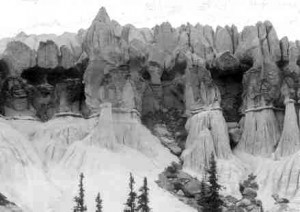Sidebar by Allen Best
Forest Management – February 2000 – Colorado Central Magazine
Listen to the ski industry dialogue long enough, and some interesting impressions begin taking shape.
First, welcome to the global marketplace, nearly all of it premised on U.S. public lands. Facing a relatively flat market in the United States, the ski areas along I-70 tried to boost their profits by appealing to more international guests, who stay longer and spend more money. Vail discovered that after hosting the World Alpine Ski Championships in 1989.
Foreigners’ piece of Vail’s fast-growing pie grew in just one year from 3% to 13%.
Aspen and Breckenridge have also been successful at attracting foreigners. The United Kingdom is their single largest market. But the long-awaited Denver-London direct flights are likely to be augmented next year by direct flights from Munich. Why ski the Alps next door when Colorado, with its usually superior snow, is so handy?
And, it’s not just Europeans. The ultra-rich of South America as well as Australians and even Canadians have been hit on. Hence, expansions such as Vail’s Category III have occurred to a notable extent to accommodate foreign visitors.
Ironically, the ski areas can’t get enough employees through conventional hiring practices, so increasingly they have turned to an immigration law, the H2B program, that allows seasonal hiring. Preferred are Aussies, Kiwis, and South Africans, since they speak English, more or less.
Finally, making this marketplace truly global, we have Intrawest, the British Columbia-based company, operating Copper Mountain and halving on the real estate base project at Keystone. For that matter, Vail’s finances extend deeply back to France.
Is this the tourism equivalent of sending old growth logs to Japan?
If so, it would not be the first time. After all, the Taos-based trappers who plied the streams in the 1820s for beaver did so in response to the whim of men in European cities.
Second, welcome to the Jekyll-Hyde train of the ’90s. Twenty years ago, the ski areas were happy to claim credit as being the engines for the economies of several mountain counties. Then, just a couple of years ago, in trying to secure permission for its Category III expansion, the ski company and the Forest Service downplayed the economic effects of just 50 to 75 more jobs to an already fevered economy. The message: all of the growth along the I-70 corridor was being sparked by other causes, not by the ski areas.
Now, in the face of limits on expansions, ski areas and, more vocally their chamber consorts, are predicting economic collapse unless expansion continues unabated. Ski areas: one year they’re the cabooses of the I-70 boom, and the next year they’re the brave little engines that could.
Category III was rechristened as Blue Sky Basin, and within hours, mouthy locals gave it a new nickname: B.S. Basin. When it was being promoted to the community and the Forest Service several years ago, it was explained as a way of providing more intermediate terrain and ensuring better early and late season conditions. But squawky environmental activists shrieked that it was just part of a terrain war. If Vail got its expansion, Breckenridge would too, and so would Keystone, and then Winter Park, and…
Guess what?
Yes, now with a season of price wars under its belt, Vail is saying that this terrain is needed as a way of competing with Copper Mountain, Winter Park, and…
This time nobody mentioned Breckenridge or Keystone. Vail Resorts now owns them.
–A.B.

